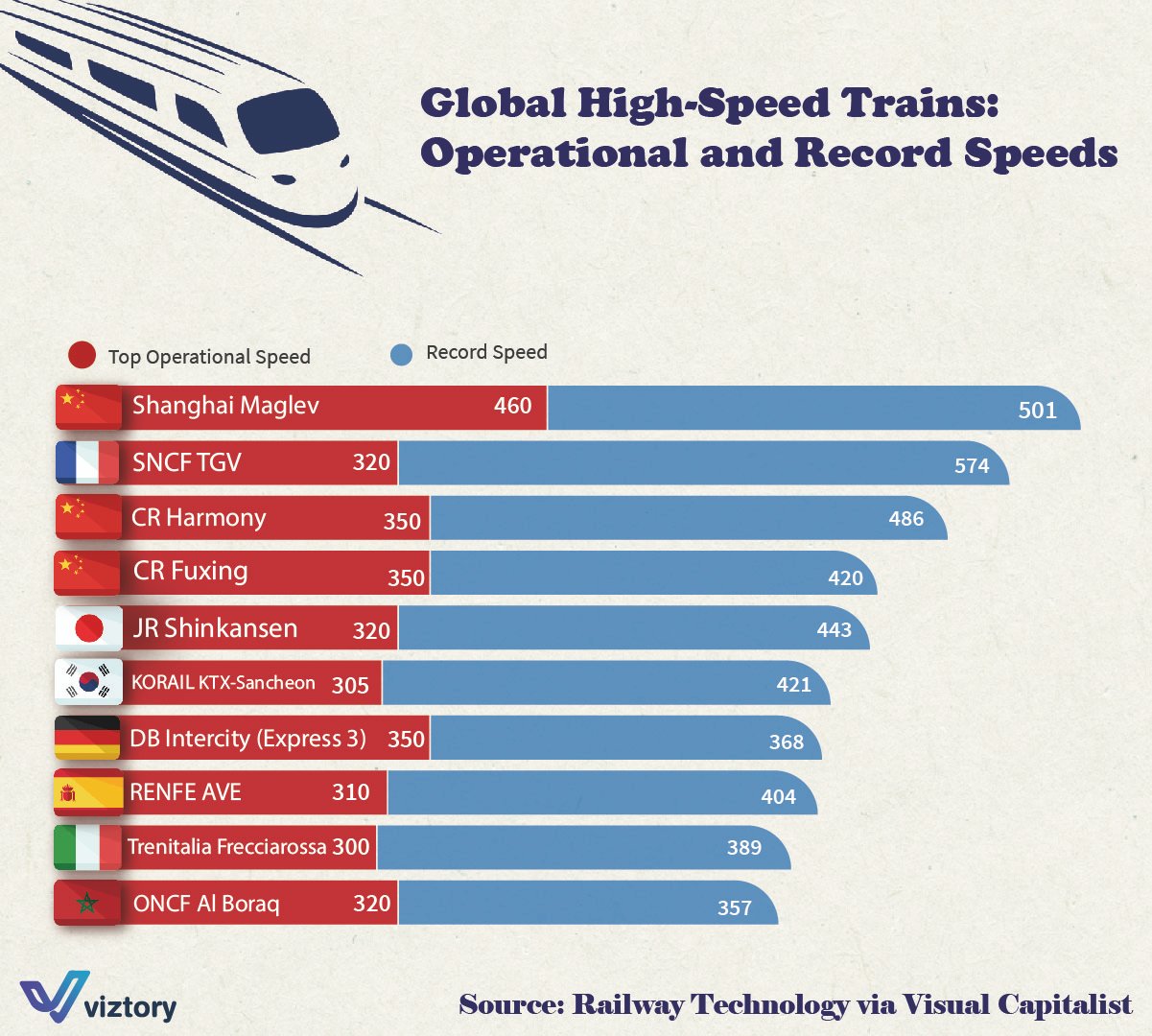Global High-Speed Trains: Engineering Marvels and the Middle East’s Emerging Role
-
Sep, Thu, 2024
Global High-Speed Trains: Engineering Marvels and the Middle East’s Emerging Role
High-speed trains are a remarkable symbol of innovation in modern transportation. As cities grow and economies evolve, the demand for faster, more efficient, and environmentally friendly transportation becomes paramount. The image above showcases some of the fastest high-speed trains in the world, demonstrating the engineering prowess of nations striving to improve mobility for millions of people.
Global Leaders in High-Speed Rail
1. Shanghai Maglev (China):
The Shanghai Maglev train takes the crown with an incredible operational speed of 460 km/h, holding a record speed of 501 km/h. Maglev (magnetic levitation) technology eliminates friction by floating the train above the tracks, allowing it to achieve such extraordinary speeds.
2. SNCF TGV (France):
France’s SNCF TGV has been a pioneer in high-speed rail since the 1980s. With an operational speed of 320 km/h and a record speed of 574 km/h, it remains a leader in Europe, continually upgrading its technology to enhance the passenger experience.
3. CR Harmony and CR Fuxing (China):
China’s rapid expansion in high-speed rail is also evident with the CR Harmony and CR Fuxing trains, which operate at 350 km/h. Their record speeds reach 486 km/h and 420 km/h, respectively, marking China as a key player in the global high-speed rail race.
4. JR Shinkansen (Japan):
Japan, the birthplace of modern high-speed rail, operates the JR Shinkansen at 320 km/h, with a record speed of 443 km/h. Known for its punctuality, safety, and efficiency, the Shinkansen is an icon of Japanese engineering.
Other Key Players:
- KORAIL KTX-Sancheon (South Korea): Operational speed of 305 km/h, record 421 km/h.
- DB Intercity Express 3 (Germany): Operational 350 km/h, record 368 km/h.
- RENFE AVE (Spain): Operational 310 km/h, record 404 km/h.
- Trenitalia Frecciarossa (Italy): Operational 300 km/h, record 389 km/h.
- ONCF Al Boraq (Morocco): Operational 320 km/h, record 357 km/h.
The Middle East’s Role in High-Speed Rail Development
The Middle East, particularly with projects like ONCF Al Boraq in Morocco, is making its way into the global high-speed rail scene. Morocco’s Al Boraq is the first high-speed train in Africa, showcasing the region’s ambitions to modernize and compete on the global stage. With operational speeds of 320 km/h and a record of 357 km/h, this project demonstrates the region’s growing interest in connecting major cities and promoting economic integration.
Beyond Morocco, the Middle East, particularly in countries like Saudi Arabia and the UAE, has been investing heavily in developing high-speed rail infrastructure as part of their vision for a more connected and technologically advanced future.
Saudi Arabia is working on several rail projects, with the Haramain High-Speed Railway already operational. This line connects the holy cities of Mecca and Medina, with trains running at speeds of 300 km/h. The country’s ambitious plans aim to expand these networks as part of its Vision 2030 initiative, ensuring faster, more sustainable travel options for pilgrims and tourists alike.
The UAE has also expressed interest in expanding its rail infrastructure, with future plans possibly including high-speed connections to neighboring Gulf Cooperation Council (GCC) countries. With ongoing discussions about regional collaboration, there is potential for high-speed rail to transform intercity travel across the Middle East.
High-Speed Rail: The Future of Global Connectivity
As the world looks to cut carbon emissions and reduce road congestion, high-speed trains are emerging as one of the most sustainable and efficient modes of transportation. The Middle East, historically known for its rich oil reserves, is beginning to diversify its economy by investing in advanced transportation systems, including high-speed rail. The region’s commitment to infrastructure modernization, coupled with its unique geographical position as a crossroads between Asia, Europe, and Africa, gives it a pivotal role in the future of global rail travel.
While countries like China, France, and Japan currently lead the way in terms of speed and innovation, the Middle East is rapidly catching up. With the success of the Al Boraq and future projects on the horizon, the region is positioning itself to be a key player in the next generation of high-speed rail travel.
In conclusion, high-speed rail represents not just a technological triumph, but also a key element in future urban development and regional connectivity. As countries continue to push the boundaries of speed, comfort, and efficiency, the Middle East is poised to join the ranks of global leaders in this transformative sector.

